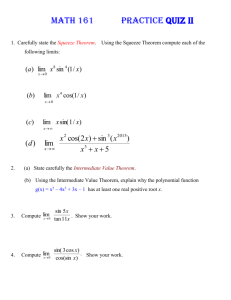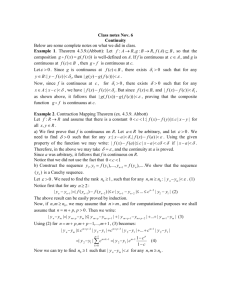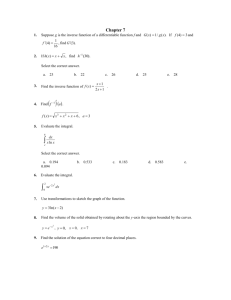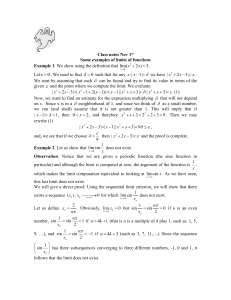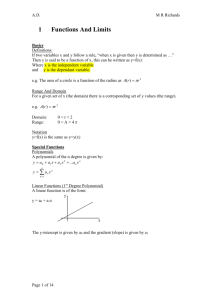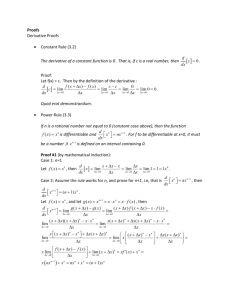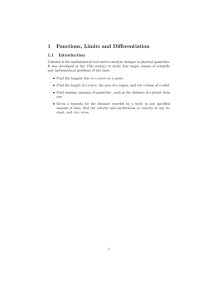here
advertisement
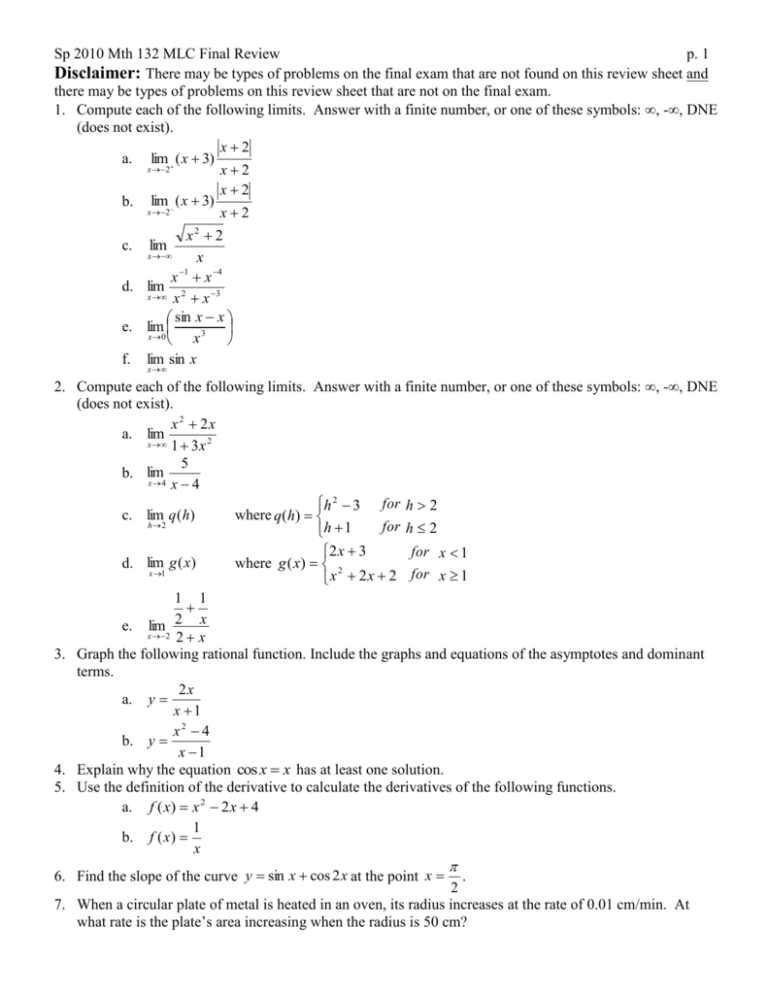
Sp 2010 Mth 132 MLC Final Review p. 1 Disclaimer: There may be types of problems on the final exam that are not found on this review sheet and there may be types of problems on this review sheet that are not on the final exam. 1. Compute each of the following limits. Answer with a finite number, or one of these symbols: , -, DNE (does not exist). x2 a. lim ( x 3) x 2 x2 x2 b. lim ( x 3) x 2 x2 x2 2 x x 1 x x 4 d. lim 2 x x x 3 sin x x e. lim 3 x 0 x f. lim sin x c. lim x 2. Compute each of the following limits. Answer with a finite number, or one of these symbols: , -, DNE (does not exist). x 2 2x a. lim x 1 3 x 2 5 b. lim x4 x 4 h 2 3 for h 2 c. lim q (h) where q(h) h 2 for h 2 h 1 d. lim g ( x) x1 3. 4. 5. 6. 7. for x 1 2 x 3 where g ( x) 2 x 2 x 2 for x 1 1 1 e. lim 2 x x 2 2 x Graph the following rational function. Include the graphs and equations of the asymptotes and dominant terms. 2x a. y x 1 x2 4 b. y x 1 Explain why the equation cos x x has at least one solution. Use the definition of the derivative to calculate the derivatives of the following functions. a. f ( x) x 2 2 x 4 1 b. f ( x) x Find the slope of the curve y sin x cos 2 x at the point x . 2 When a circular plate of metal is heated in an oven, its radius increases at the rate of 0.01 cm/min. At what rate is the plate’s area increasing when the radius is 50 cm? Sp 2010 Mth 132 MLC Final Review p. 2 Disclaimer: There may be types of problems on the final exam that are not found on this review sheet and there may be types of problems on this review sheet that are not on the final exam. 8. The radius of a sphere is increasing at a rate of 2 mm/sec. How fast is the volume increasing when the 4 radius is 10 mm? V r 3 3 9. For each of the functions below find the value of c such that the function is continuous or state that there is “no such c”. x2 1 x 1 a. f ( x) x 1 c x 1 x 2 5x 4 if x 1 b. f ( x) x 1 c if x 1 10. Find the derivative of the following functions a. g (t ) 4 sec t tan t b. y 3 1 x 3 c. h( x) sin 5 x cos 5 x sin x d. y 1 cos x 1 e. y x x 2 x x 1 f. f (t ) 4 2 t 2t 5 dy 11. Find dx a. y (sin x cos x) sec x 1 b. y x 2 cot x 2 x 2 2 c. 8 x y 10 d. y x sin y 2 3 e. y sin xy 5 x2 f. y ln t dt (Assume that the function ln t is continuous.) x 12. Find the equation of the tangent line to the graph of the equation at the given point. x 1 a. y 1, x 1 2 b. xy 16 0 (-2, 8) 13. If the tangent line to the curve y 4 2 x 2 at the point where x = a is parallel to the line 8 x 3 y 4 , then a= 14. Use a linear approximation to estimate 3 994 . Sp 2010 Mth 132 MLC Final Review p. 3 Disclaimer: There may be types of problems on the final exam that are not found on this review sheet and there may be types of problems on this review sheet that are not on the final exam. 15. Show that the following functions have exactly one zero in the given interval. a. f ( x) x 4 3x 1 [-2, -1] (, ) b. r ( ) sin 2 8 3 x 12 2(1 x 2 ) 4 x( x 2 3) Give the all the requested information. f ( x ) 1 x2 (1 x 2 ) 2 (1 x 2 ) 3 Give both coordinates (x, y) of the intercepts, local extrema and points of inflection, and give an equation for each asymptote. Write NONE where appropriate. 16. f ( x) f ( x) Intercepts: Horizontal Asymptotes: Vertical Asymptotes: Intervals f is increasing: Intervals f is decreasing: Local Maxima: Local Minima: Intervals of Concave Down: Intervals of Concave Up: Points of Inflection: 17. A 216 m2 rectangular pea patch is to be enclosed by a fence and divided into two equal parts by another fence parallel to one of the sides. What dimensions for the outer rectangle will require the smallest total length of fence? How much fence will be needed? 18. You are designing a rectangular poster to contain 50 in2 of printing with a 4-in margin at the top and bottom and a 2-in. margin at each side. What overall dimensions will minimize the amount of paper used? 19. Use Newton’s method to estimate the solutions of the equation x 2 x 1 0 . a. Start with x0 = -1 and find x1 b. Start with x0 = 1 and find x1 20. Using the following functions use finite approximation to estimate the area between the f ( x) x 2 and the x-axis. a. On the interval [0, 1] use a lower sum with two rectangles of equal width b. On the interval [1, 2] use a upper sum with four rectangles of equal width c. On the interval [1, 4] use a right-hand endpoint with two rectangle of equal width d. On the interval [0, 3] use a left-hand endpoint with four rectangles of equal width 21. Evaluate the following definite and indefinite integrals 2 a. 4 x 2 dx x 2 (Hint: interpret it in terms of an area) 2 1 b. x 1 dx 0 1 2 c. t 1 d. 2 2 t dt sin( 2 x)dx 0 Sp 2010 Mth 132 MLC Final Review p. 4 Disclaimer: There may be types of problems on the final exam that are not found on this review sheet and there may be types of problems on this review sheet that are not on the final exam. sin( x) cos e. 2 ( x) dx 0 22. Evaluate the following definite and indefinite integrals 2 cos sin a. 3 d 6 b. tan c. x sin x d. cos 3 ( x) 1 cos 2 x dx e. csc( x) cot( x) dx 2 f. 4 t dx t3 3 x sec 2 x dx 2 1 dx x 23. If F ( x) e t dt , then F (4) 2 0 24. Find the area of the region enclosed by the curves: y 7 2 x 2 and y x 2 4 25. Find the area of the region enclosed by the curves: x y 3 y 2 and x 2 y 26. Determine the value of a that makes the limit exists: h 2 3 for h 2 lim q (h) where q(h) h 2 for h 2 h a 27. A right circular cylinder is inscribed in a cone of height 12 in and base radius 6 in. Find the radius of such a cylinder with largest possible volume. (Let h denote the height and r the radius of the cylinder). dy 3 sin 2 x 6 , y (0) 1 dx 29. A particle is moving with acceleration a(t ) cos t sin t . Its initial position is s (0) 5 and its initial velocity is v (0) 3 . Find the position function s (t ) . 28. Solve the initial value problem: 30. Consider the function f ( x) x 2 3x 2 on [0, 4]. Find the total area between the curve and the x-axis.
